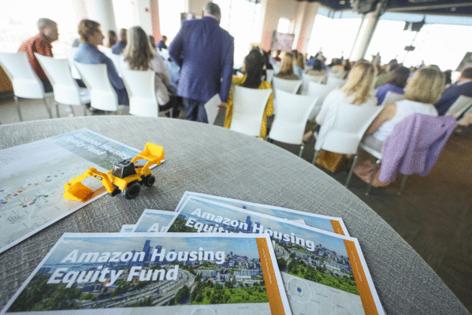Amazon pledged to support affordable housing. How has it fared so far?
Published in Business News
It's a sunny, September day in SeaTac, Washington, and three kids are playing in the courtyard of Connection Angle Lake, a new 130-unit affordable housing project roughly 50 feet from the last stop on Sound Transit's 1 Line.
Inside, the studios, one-bedroom and multi-bedroom apartments look fresh with stainless steel appliances and views that give a peek of Mount Rainier.
The proximity to the light rail is no coincidence. The site was acquired by Sound Transit in 2013 and purchased at a discount by affordable housing organization Mercy Housing in 2022. The transit-oriented housing project made a perfect candidate for Amazon's Housing Equity Fund, which contributed a $17 million low-interest rate loan and a $2 million grant.
The 130 units, about 40% of which have been scooped up in the past few months, are part of the now 10,000 units Amazon's cash has helped build in the Puget Sound region, most of which are required to be affordable for 99 years.
Acknowledging its role in making the Seattle area considerably less affordable, Amazon launched its fund in 2021 with an initial commitment of $2 billion in the form of loans and grants to create and preserve 20,000 affordable housing units across three metro areas where Amazon's presence is acutely felt: Seattle, Arlington, Virginia, and Nashville, Tennessee.
The fund was supposed to stretch out over five years, but last year the company said it already exceeded the goal. The projects it funded had completed 21,000 units, 8,600 of which were in the Seattle area.
The company then committed another $1.4 billion to create an additional 14,000 homes across the three cities.
Now, it has hit 10,000 units in the Seattle area.
"Here at home, 10,000 units is a big milestone," said Alice Shobe, global director of Amazon Community Impact. "We set out early to move quickly and we did. I think the payoff of those 10,000 units is going to show especially in decades to come when those 99 years of affordability are required and we're not flipping over housing as quickly."
Amazon isn't the only tech giant to commit funds to public housing. Apple, Meta, Google and Microsoft have all launched funds, most of them doing so before Amazon. But the results have been mixed. The Wall Street Journal reported in August that while some projects funded by Meta and Google in 2019 have moved forward, others have been mired by local regulation and other slowdowns in development.
Some companies have committed their own land, others have issued loans.
Amazon's approach is to pick out local developers and housing authorities and supplement existing funding with loans and grants.
Most of the affordable housing Amazon supports has area median income ranges between 50% and 80%. Plainly, that means a tenant can't make more than 80% of the given area's median income to be eligible. In Seattle, the AMI is about $110,000 for an individual.
Shobe said that focus is intentional, as existing resources from the federal government historically tend to funnel toward the low end of affordable housing, below the 50% AMI mark.
"If you look at the workforce in the community, you have a lot of teacher assistant and security guards and other folks that aren't able to meet the rents that our region has reached," Shobe said. "So what we did is we really focused on that middle area."
In Seattle, the tech and e-commerce giant has also funneled money toward projects in neighborhoods where residents are at risk of displacement. Beacon Pacific Village, a 160-unit apartment complex requiring 50% to 60% AMI in front of Amazon's former headquarters in the Pacific Tower, opened last year and has been fully leased since April, mostly with community members, according to the Seattle Chinatown International District Preservation and Development Authority, which helped develop the units.
"Having housing led by community development organizations provides more culturally entrenched affordable housing for the community," said Jade Yan, SCIDpda's resident services manager. "It's just so crucial. Housing means stability and security."
The complex is an ideal project for Amazon's housing fund, ticking off all of the boxes of Shobe's vision. It's near transit, it has units with as many as four bedrooms to support multigenerational families and it has a community preference program to push against the tide of gentrification.
The company has funded projects as far north as Everett and as far south as Tacoma, but the most development has occurred in Seattle and Bellevue, with 5,216 units and 1,486 units built so far.
Shobe said Amazon's housing investments have resulted in a 31% increase in affordable housing stock in Bellevue.
But Amazon is pumping more units into an affordable housing market that's in a much more awkward spot than it was when Amazon announced the fund. Flattened rents in Seattle are undercutting affordable housing rents, leaving publicly funded housing with higher vacancy rates.
The Seattle Times reported last month that while more affordable housing for the low- to middle-income tenants is built, there's a dwindling supply for extremely low-income.
Shobe said Amazon is aware of the need for lower-income housing and manages the tension its own supply of 50% to 80% AMI housing it's putting on the market.
"If you look at our portfolio, it's concentrated in that 50 to 80% range, but we do have very much a mixed portfolio," she said. "We do have a significant number of units that are helping families under that 50% median income."
©2025 The Seattle Times. Visit seattletimes.com. Distributed by Tribune Content Agency, LLC.















Comments